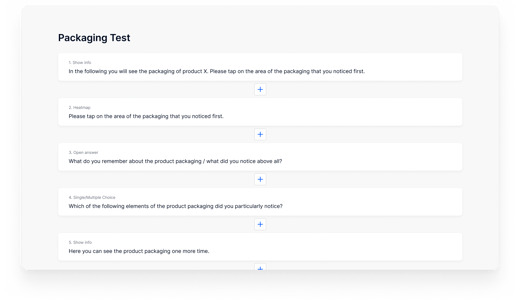Design-Test: How to test a Design properly?
Appinio Research · 13.12.2022 · 13min read

Content
It's not always easy to capture the essence of a brand or communicate its benefits through corporate logos, claims, out-of-home advertising, online ads, or packaging.
That's why it's essential to conduct a design test with your target audience instead of relying on your instincts.
Good design can capture consumers' attention, enhance brand recognition, and influence purchasing decisions.
Who better to provide feedback on which design or advertising measure is most effective than your target audience?
Appinio offers iterative design testing until you find the perfect solution, regardless of what you're testing, whether it's a logo, film trailer, or online ad. The questionnaire structure for a design test is always the same, and we'll show you what it looks like at the end of this article.
Our market research experts from Appinio will explain in detail what you need to consider for various design tests.
Name Test
A company, a brand or a product requires an appealing and memorable name.
In a name test it is important to find out whether the target group understands it and whether it is attention-grabbing and well remembered.
It should be easy to pronounce and write.
And, choose a unique name to set yourself apart from the competition.
💡On our Appinio platform, you will find a questionnaire template and a sample survey to see exactly how a name test works. Sign up for free and set up your study.
Logo Test
A company's logo is the face of their brand and a crucial branding element that represents their corporate identity. It should be visually appealing, easily recognizable, and reflect the personality and values of the brand.

💡Did you know that in the Appinio platform you can find templates and study samples to get your study started in minutes?
Claim Test
A slogan or claim represents a brand and communicates the brand's promise to the consumer in a concise form.
It should be catchy and, more importantly, easily understood by the target audience.
However, our studies have shown that this is not always the case.
Many brands all over the world use English claims leaving non-English audiences wondering.
💡Does your target audience understand your product claims? Find out with Appinio.
Testing Advertising Material
Are your advertising materials effectively conveying your message?
Are they visually appealing, easy to understand, and driving the desired action from your target audience?
Consulting with your current and potential customers can help optimize your creatives before wasting valuable marketing budget on ineffective advertising materials.
Video Test, TV Spot Test, Radio Spot Test and Film Trailer testing
Spot testing can help determine if advertising resonates with your target audience and if they understand the intended message.
There is typically room for improvement in design tests, regardless of the advertising medium, whether it's video, TV, radio, or cinema.
It's not necessary to have a finished spot for a survey, and testing different versions can help identify which creative performs best depending on the objective.
💡 Find questionnaire templates and sample surveys in the Appinio platform. Get started and get results on your spot in minutes!
Advertising Posters and Online Ads
Before launching your ad posters or online ads, it's crucial to test your advertising concepts with your target audience.
Ask for their feedback on different versions, and learn how they associate each concept with your brand.
Does it trigger curiosity and encourage the desired action, such as a product purchase, app download, or online shop visit?
Gathering this information can help optimize your advertising materials for maximum effectiveness. Additionally, A/B testing can be used to compare and determine which version performs best with your target audience.
Product Design Testing
The appearance of a product is a critical factor in capturing the attention of potential customers and establishing brand loyalty.
It's essential to understand which design variants are most appealing to your target audience and whether the product design aligns with your brand and evokes the desired associations.
Conducting a product design test can help you identify strengths and areas for improvement in your product's design, ensuring that it resonates with your target audience and drives customer loyalty.
Packaging Design Testing
Packaging design plays a critical role in influencing purchase decisions, as customers often shop visually and impulsively.
The appearance and information on your product's packaging can make or break its chances of ending up in the shopping cart.
An eye-catching packaging design that resonates with your target audience can differentiate your product from competitors on the shelf.
To increase the probability of purchase, it's essential to gather feedback directly from your target audience on different packaging designs.
💡 Want to test your packaging or product design? Find a questionnaire template and a sample survey to get you started in the Appinio platform!
Implementation of a Design Test
Questionnaire Structure for a Design Test
Regardless of whether you want to test a logo, a film trailer or an online advertisement, you'll need a bulletproof questionnaire.
💡 On our Appinio platform you will find many ready-made questionnaires depending on different use cases, those can be easily adapted to your needs.
If you're conducting a design test, consider using the following questionnaire structure as a starting point:
- General evaluation
Ask participants to rate the design using a Likert scale, from "I don't like it at all" to "I like it very much".
Follow up with an open-ended question to gather detailed feedback on what they like or dislike about the design. - Association testing
Inquire about the associations the design evokes, such as the product or brand it represents. Use an open-ended question to gather unsupported responses, then provide a list of options to choose from to support their associations. - Comparison testing
Show participants the evaluated design as well as other variants, and ask them to choose which one they like best or find most modern.
Conclude the questionnaire with a question about whether the design motivates the target group to take the desired action, such as visiting a website, going to the cinema, or buying the product.
Monadic vs. Semi-Monadic Tests
Monadic and semi-monadic surveys are both commonly used in design tests.
What is monadic testing?
Monadic testing involves showing each survey participant only one survey object. For example, in a design test, each participant would be asked to rate just one logo variant, advertising medium, or film trailer.
This approach allows for more individualized evaluations, as respondents are not influenced by multiple survey objects.
What is semi-monadic testing?
On the other hand, semi-monadic testing involves asking each survey participant to evaluate several survey objects, such as different design variants. The same questionnaire is completed multiple times within a survey, with respondents rating each object separately.
However, there is a risk that respondents may be influenced by the first object they see and may evaluate all subsequent objects in relation to it.
To mitigate this risk, in semi-monadic tests, the questions for different designs are created in blocks and then randomized. This helps to avoid a sequence effect among respondents. However, the questionnaire in semi-monadic tests is typically longer than in monadic tests, which can cause respondent fatigue and result in less detailed responses.
Overall, monadic tests provide more meaningful individual evaluations as respondents are not influenced by different survey objects.
Additionally, the questionnaire is typically shorter, making it less burdensome for respondents.
For these reasons, monadic surveys are recommended for design tests, particularly for spot tests, such as for videos or film trailers, which require a lot of attention and concentration from respondents.
Interested in running your own study?
In our dashboard, you will find questionnaire templates that you can customize and get the insights you need to bring your brand to the next level.
Get facts and figures 🧠
Want to see more data insights? Our free reports are just the right thing for you!



